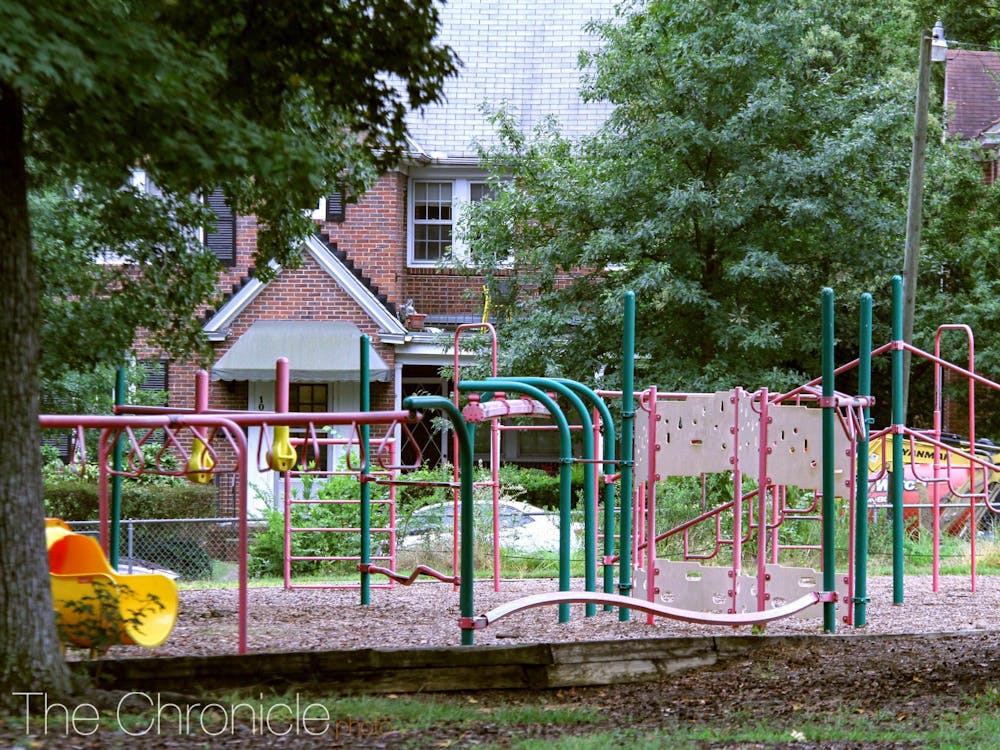When senior Tyler Long decided to pursue a teaching license after taking Education 101 his first year at Duke, he didn’t think his first foray into teaching would be behind a computer instead of a desk; three days a week instead of five; with two faces on a screen when, in person, he would see 20.
Duke’s Secondary Teacher Preparation Program grants undergraduate students a North Carolina teaching license for ninth grade through 12th grade if they complete a teaching internship at a Durham public high school in their senior spring semester. This year’s cohort of 10 student-teachers is the first to do the entire three-month internship remotely.
While teachers last spring scrambled to move their classes onto virtual platforms, student-teachers will now have to face a transition back to in-person teaching without ever having taught in a classroom.
Student-teachers are paired with a mentor teacher, whom they observe during the fall. Then, from January to March, the student assumes all of the teacher’s responsibilities, including teaching the course, planning lessons, grading assignments and attending faculty meetings and parent teacher conferences.
“We’ve had people come to us and say that there’s always a challenging period in a teacher’s tenure where they question what the heck they’re doing, and we’re sort of already in it,” said Long, who is teaching Advanced Placement United States Government and Politics at Charles E. Jordan High School.
After attending high school in Robbinsville, N.C., where the curriculum “wasn’t up to par,” Long developed a passion for curriculum development. He envisioned that when he became a teacher, he would offer students a “culturally responsive curriculum, where we’re taking in all of the varied perspectives in the classroom and making it truly inclusive.”
It’s been hard to achieve this goal when one of the biggest difficulties of remote teaching is fostering conversation among students. In a normal year, Long would be teaching students for seven and a half hours a week. Now, he only sees them for a total of three hours, and in order to finish the curriculum, he has to exclude discussions and debates within the class that are normally hallmarks of the educational experience.
“I want to ask them, ‘How do you think the electoral college is antithetical to American democracy?’ or ‘Do you think that the presidential cabinet should reflect society? Why do you think that?’” Long said. “But now, it’s more a ‘think about it on your own and let me know’ situation.”
For senior Raquel Butner, who teaches ninth grade world history at the same high school, uncertainty about whether students are engaging with the material has been a concern. Since Jordan High School doesn’t require students to turn their cameras on during class, a majority don’t. If a student does have it on, Butner makes it a point to thank them over Zoom private message.
She’s also found that sending her students a Google form with questions related to the lesson or the video at the beginning of class allows her to gauge their understanding. Even then, some students won’t fill out the form until a month after the class, Butner said.
Long and Butner have also found that the remote setting makes it difficult to support their students socially and emotionally. Butner is considering making a check-in for her students at the top of her Google forms: on a scale of one to five, one being the worst and five being the best, how are you feeling today?
“The onus is a lot more on them, which really sucks. I can send out emails all day long. I can remind them about office hours. But at the end of the day, if they click that ‘leave meeting’ button, they won’t be there to speak to you even if you want them to be,” Long said.
He’s put more emphasis on his availability as a resource now than he would have if they were in-person.
Despite the frustrations, having to address these challenges so early in their teaching careers may prove to be an asset once in-person learning resumes.
“It can’t get worse than this,” Long said.
Getting students engaged is harder during remote learning, said Susan Wynn, Associate Professor of the Practice of Education and director of the Program in Education. “In the classroom, I suspect ways to do that will come more quickly and naturally,” Wynn said.
Butner, however, has reservations about her readiness. While she agrees that teaching the material will be easier, she said the virtual setting means she hasn’t had to confront the more difficult responsibilities of the role.
“I don’t want to generalize, but I’m not sure if my group is ready for what we’re going to see in a classroom. What are you going to do if you see a kid with bruises all over them when they come into school from their house? We don’t see that right now,” she said. “There are some things that are going to happen that I think can probably shake us to our core.”
The student teachers will also have to deal with classroom management and conflict resolution for the first time in person. Over Zoom, they haven’t had to quiet down a classroom or reprimand kids talking out of turn because most of them don’t talk at all. If a student is sleeping or on their phone while their camera is off, the student-teachers won’t know. Right now, there’s no need to discipline a student.
While Wynn plans on teaching them some classroom management skills later in the semester, there is only so much that can be prepared for without first-hand experience. Aside from connecting with their students, practicing these skills until fluency is the biggest thing Butner feels she’s missed out on.
Yet Butner and Long have no regrets about doing the program remotely. When Long first heard it would be online, he considered postponing his teaching license until after law school. The other students in the program convinced him to stay.
“The education world, especially in North Carolina, is hurting enough as it is that we just don’t want to give up on it,” Long said.
Parents were “divided over the Durham school district’s determination to stick with online classes as a precaution against the COVID-19 pandemic,” The News & Observer reported in February. Durham high schools ultimately decided to reopen in April.
Teaching during this time has been a reminder that sometimes parents see teachers more as babysitters than professionals, said Butner, who plans to pursue education policy after a few years of teaching.
In spite of everything, the undergraduates have still been able to find moments that remind them why they got into teaching: to connect with students. An email from a student asking what assignments they can do to bring their grade up, a class singing happy birthday over Zoom or shy student private messaging an answer to a question goes a long way.
One student even turned his assignment in with a note: “I like this class so much now. Thank you, Mr. Long.”
Get The Chronicle straight to your inbox
Signup for our weekly newsletter. Cancel at any time.

Milla Surjadi is a Trinity junior and a diversity, equity and inclusion coordinator of The Chronicle's 119th volume. She was previously editor-in-chief for Volume 118.

